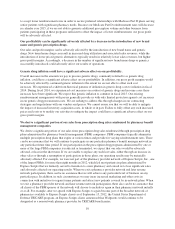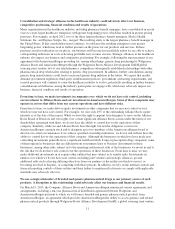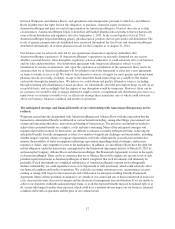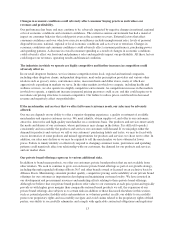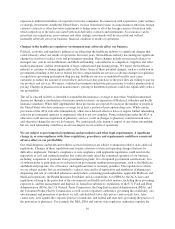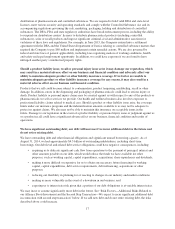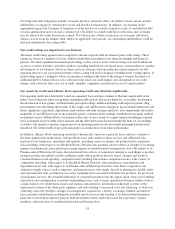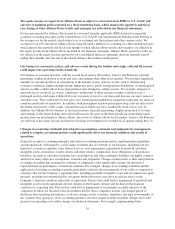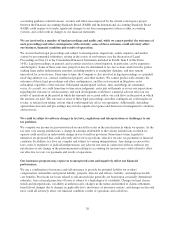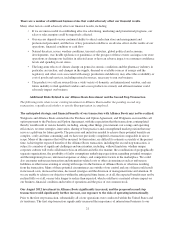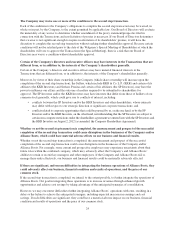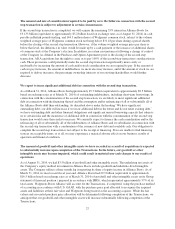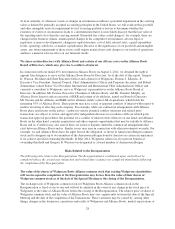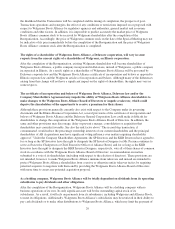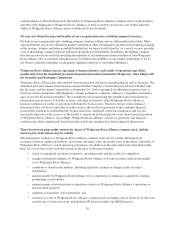Walgreens 2014 Annual Report Download - page 28
Download and view the complete annual report
Please find page 28 of the 2014 Walgreens annual report below. You can navigate through the pages in the report by either clicking on the pages listed below, or by using the keyword search tool below to find specific information within the annual report.accounting guidance related to leases, revenue and other areas impacted by the current convergence project
between the Financial Accounting Standards Board (FASB) and the International Accounting Standards Board
(IASB) could require us to make significant changes to our lease management system or other accounting
systems, and could result in changes to our financial statements.
We are involved in a number of legal proceedings and audits and, while we cannot predict the outcomes of
such proceedings and other contingencies with certainty, some of these outcomes could adversely affect
our business, financial condition and results of operations.
We are involved in legal proceedings and subject to investigations, inspections, audits, inquiries and similar
actions by governmental authorities, arising in the course of our business (see the discussion of Legal
Proceedings in Note 12 to the Consolidated Financial Statements included in Part II, Item 8 of this Form
10-K). Legal proceedings, in general, and securities and class action litigation, in particular, can be expensive
and disruptive. Some of these suits may purport or may be determined to be class actions and/or involve parties
seeking large and/or indeterminate amounts, including punitive or exemplary damages, and may remain
unresolved for several years. From time to time, the Company is also involved in legal proceedings as a plaintiff
involving antitrust, tax, contract, intellectual property and other matters. We cannot predict with certainty the
outcomes of these legal proceedings and other contingencies, and the costs incurred in litigation can be
substantial, regardless of the outcome. Substantial unanticipated verdicts, fines and rulings do sometimes
occur. As a result, we could from time to time incur judgments, enter into settlements or revise our expectations
regarding the outcome of certain matters, and such developments could have a material adverse effect on our
results of operations in the period in which the amounts are accrued and/or our cash flows in the period in which
the amounts are paid. The outcome of some of these legal proceedings and other contingencies could require us
to take, or refrain from taking, actions which could negatively affect our operations. Additionally, defending
against these lawsuits and proceedings may involve significant expense and diversion of management’s attention
and resources.
We could be subject to adverse changes in tax laws, regulations and interpretations or challenges to our
tax positions.
We compute our income tax provision based on enacted tax rates in the jurisdictions in which we operate. As the
tax rates vary among jurisdictions, a change in earnings attributable to the various jurisdictions in which we
operate could result in an unfavorable change in our overall tax provision. From time to time, legislative
initiatives are proposed that could adversely affect our tax positions, effective tax rate, tax payments or financial
condition. In addition, tax laws are complex and subject to varying interpretations. Any change in enacted tax
laws, rules or regulatory or judicial interpretations, any adverse outcome in connection with tax audits in any
jurisdiction or any change in the pronouncements relating to accounting for income taxes could adversely affect
our effective tax rate, tax payments and results of operations.
Our insurance program may expose us to unexpected costs and negatively affect our financial
performance.
We use a combination of insurance and self-insurance to provide for potential liability for workers’
compensation, automobile and general liability, property, director and officers’ liability, and employee health
care benefits. Provisions for losses related to self-insured risks generally are based upon actuarially determined
estimates. Any actuarial projection of losses is subject to a high degree of variability. Changes in legal claims,
trends and interpretations, variability in inflation rates, changes in the nature and method of claims settlement,
benefit level changes due to changes in applicable laws, insolvency of insurance carriers, and changes in discount
rates could all adversely affect our financial condition, results of operations and cash flows.
20


